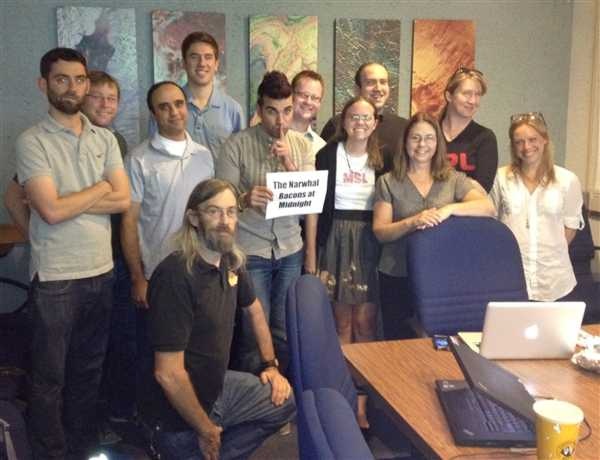
This NASA graphic released before the Mars rover Curiosity's Aug. 5, 2012, landing shows one possible route up the nearby Mount Sharp inside Gale Crater.The blue line indicates the potential driving route to geological destinations identified from orbit.
CREDIT: NASA/JPL-Caltech/ESA/DLR/FU Berlin/MSSS
-
NASA will hold a press conference today (Aug. 17) to give a status update on the Mars rover Curiosity, which is poised to take its first drive on the Red Planet next week.
The briefing will take place at 1:30 p.m. EDT (1730 GMT) in a teleconference that will be webcast online for the public.
-

Members of the Curiosity rover's mission control team look into the camera for a group portrait at NASA's Jet Propulsion Laboratory in advance of a Reddit "Ask Me Anything" chat session.
Update: 18.08.2012 / 0.15 MESZ
PASADENA, Calif. -- The scientists and engineers of NASA's Curiosity rover mission have selected the first driving destination for their one-ton, six-wheeled mobile Mars laboratory. The target area, named Glenelg, is a natural intersection of three kinds of terrain. The choice was described by Curiosity Principal Investigator John Grotzinger of the California Institute of Technology during a media teleconference on Aug. 17.
"With such a great landing spot in Gale Crater, we literally had every degree of the compass to choose from for our first drive," Grotzinger said. "We had a bunch of strong contenders. It is the kind of dilemma planetary scientists dream of, but you can only go one place for the first drilling for a rock sample on Mars. That first drilling will be a huge moment in the history of Mars exploration."
The trek to Glenelg will send the rover 1,300 feet (400 meters) east-southeast of its landing site. One of the three types of terrain intersecting at Glenelg is layered bedrock, which is attractive as the first drilling target.
"We're about ready to load our new destination into our GPS and head out onto the open road," Grotzinger said. "Our challenge is there is no GPS on Mars, so we have a roomful of rover-driver engineers providing our turn-by-turn navigation for us."
Prior to the rover's trip to Glenelg, the team in charge of Curiosity's Chemistry and Camera instrument, or ChemCam, is planning to give their mast-mounted, rock-zapping laser and telescope combination a thorough checkout. On Saturday night, Aug. 18, ChemCam is expected to "zap" its first rock in the name of planetary science. It will be the first time such a powerful laser has been used on the surface of another world.
"Rock N165 looks like your typical Mars rock, about three inches wide. It's about 10 feet away," said Roger Wiens, principal investigator of the ChemCam instrument from the Los Alamos National Laboratory in New Mexico. "We are going to hit it with 14 millijoules of energy 30 times in 10 seconds. It is not only going to be an excellent test of our system, it should be pretty cool too."
Mission engineers are devoting more time to planning the first roll of Curiosity. In the coming days, the rover will exercise each of its four steerable (front and back) wheels, turning each of them side-to-side before ending up with each wheel pointing straight ahead. On a later day, the rover will drive forward about one rover-length (10 feet, or 3 meters), turn 90 degrees, and then kick into reverse for about 7 feet (2 meters).
"There will be a lot of important firsts that will be taking place for Curiosity over the next few weeks, but the first motion of its wheels, the first time our roving laboratory on Mars does some actual roving, that will be something special," said Michael Watkins, mission manager for Curiosity from the Jet Propulsion Laboratory in Pasadena, Calif.

Martian Treasure Map
This image shows the landing site of NASA's Curiosity rover and destinations scientists want to investigate. Curiosity landed inside Gale Crater on Mars on Aug. 5 PDT (Aug. 6 EDT) at the green dot, within the Yellowknife quadrangle. The team has chosen for it to move toward the region marked by a blue dot that is nicknamed Glenelg. That area marks the intersection of three kinds of terrain. The science team thought the name Glenelg was appropriate because, if Curiosity traveled there, it would visit it twice -- both coming and going -- and the word Glenelg is a palindrome. Then, the rover will aim to drive to the blue spot marked "Base of Mt. Sharp", which is a natural break in the dunes that will allow Curiosity to begin scaling the lower reaches of Mount Sharp. At the base of Mt. Sharp are layered buttes and mesas that scientists hope will reveal the area's geological history.
These annotations have been made on top of an image acquired by the High Resolution Imaging Science Experiment (HiRISE) camera on NASA's Mars Reconnaissance Orbiter.
Image credit: NASA/JPL-Caltech/Univ. of Arizona
